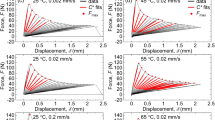Abstract
This paper establishes a simple testing scheme to simultaneously measure the linear elastic strain energy release rate G, the non-linear J-integral, and the rate-dependent C *-integral for a growing crack at a polymer/metal interface. The test is applicable to fracture of adhesive bonds. A criterion governing C *-controlled fracturing is derived, analogous to the Hutchinson-Paris ω-criterion for J-controlled growth. The interfacial toughness of an adhesive commonly used for bonding metal plates is characterized at room temperature, and is shown to fracture in a C *-controlled manner. A relationship between C * and the crack growth rate is observed. The nature of this relationship warrants further exploration.
Similar content being viewed by others
References
Cheung, C.Y. and Cebon, D. (1997). Experimental study of pure bitumen in tension, compression, and shear. J. Rheology 41, 45–73.
Evans, A.G., Dalgleish, B.J., He, M. and Hutchinson, J.W. (1989). On crack path selection and the interface fracture energy in bimaterial systems. Acta Metall. 37, 3249–3254
Fleck, N.A. (1982). The Use of Compliance and Electrical Resistance Techniques to Characterize Fatigue Crack Closure. Cambridge University Engineering Department Technical Report.
Goldman, N.L. and Hutchinson, J.W. (1975). Fully plastic crack problems: The center-cracked strip under plain strain, International Journal of Solids Structures 11, 575–591.
Harvey, J.A.F. and Cebon, D. (2003) Failure mechanisms in viscoelastic films. Journal of Materials Science 38, 1021–1032.
Hutchinson, J.W. (1968). Singular behavior at the end of a tensile crack in a hardening material. J. Mechanics Physics Solids 16, 13–31.
Hutchinson, J.W. and Paris, P.C. (1979). Stability analysis of J-controlled crack growth, Elastic-Plastic Fracure, ASTM STP 668, 37–64.
Kinloch, A.J. (1987). Adhesion and Adhesives: Science and Technology. Dordrecht: Kluwer Academic Publishers.
Kysar J.W. (2001a). Continuum simulations of directional dependence of crack growth along a copper/sapphire bicrystal interface. Part I: experiments and crystal plasticity background. J. Mech. Phys. Solids 49(5), 1099–1128.
Kysar, J.W. (2001b). Continuum simulations of directional dependence of crack growth along a copper/sapphire bicrystal interface. Part II: crack tip stress/deformation analysis. J. Mech. Phys. Solids 49(5), 1129–1153.
Landes, J.D. and Begley, J.A. (1976). A fracture mechanics approach to creep crack growth. ASTM STP 590, 128.
Liechti, K.M. and Chai, Y.-S. (1991). Asymmetric shielding in interfacial fracture under in-plain shear. J. Appl. Mech 58(3), 680–687.
Mumm, D.R. and Evans, A.G. (2000). On the role of imperfections in the failure of a thermal barrier coating made by electron beam deposition. Acta Mater. 48, 1815–1827.
Nikbin, K.M., Webster, G.A. and Turner, C.E. (1976). Cracks and fracture, ASTM STP 601, 47–62.
Ohji, K., Ogura, K. and Kubo, S. (1979). Stress-strain fields and modified J-integral in the vicinity of the crack tip under transient creep conditions. Japan Society of Mechanical Engineering 790-13, 18–20.
Paris, A.J. and Paris, P.C. (1988). Instantaneous evaluation of Jand C*. International J. Fracture 38R19–R21.
Riedel, H. (1987). Fracture at High Temperatures. Springer-Verlag.
Riedel, H. and Wagner, W. (1981). The growth of macroscopic cracks in creeping materials, International Conference on Fracture 5(2), 683–690.
Riedel, H. and Rice, J.R. (1980). Tensile cracks in creeping solids, ASTM STP 700, 112–130.
Rice, J.R., and Rosengren, G.F. (1968). Plane strain deformation near a crack tip in a power law creeping material. J. Mechanics Physics Solids 16, 1–12.
Saxena, A. (1980). Evaluation of C* for the characterization of creep crack-growth behavior in 304 stainless steel, ASTM STP 700, 131–151.
Varias, A.G., Suo, Z. and Shih, C.F. Ductile failure of a constrained metal foil. J. Mechanics Physics Solids 39(7), 963–986.
Author information
Authors and Affiliations
Rights and permissions
About this article
Cite this article
Ji, S.S., Genin, G.M., Paris, P.C. et al. Polymer/metal interfacial crack growth characterized by C* . International Journal of Fracture 129, 63–73 (2004). https://doi.org/10.1023/B:FRAC.0000038908.73873.ac
Issue Date:
DOI: https://doi.org/10.1023/B:FRAC.0000038908.73873.ac




